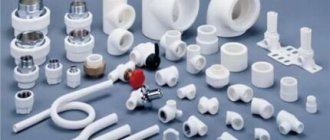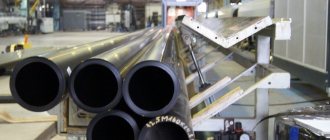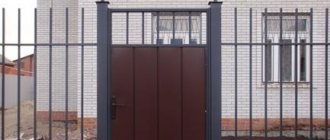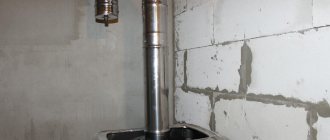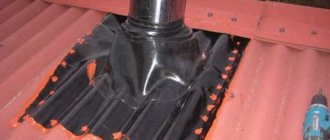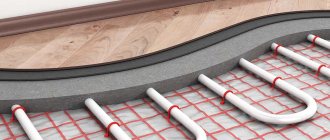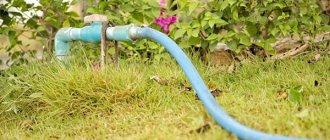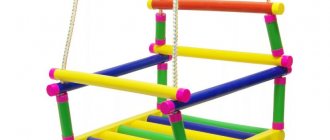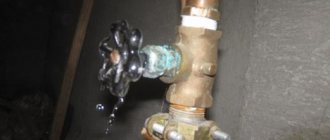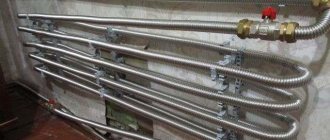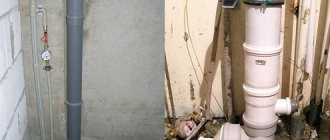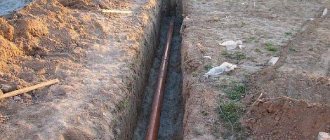Polyethylene multilayer pipes (HDPE) are a complex structure created by the polymerization of ethylene without the use of high pressure. Thanks to their multilayer structure, these pipes are quite strong and at the same time flexible. Low cost, variety of types and unpretentiousness make it possible to use HDPE pipes for water supply in the country, the installation of which is easy to do with your own hands.
At your summer cottage, you can install a water supply using polyethylene pipes
Installation of HDPE water supply
Pipes made of polymer materials today act as successful competitors to metal and asbestos-cement products, being increasingly used for laying water supply systems. This is due to a wide range of plastic pipes made from various polymers with different technical characteristics. As a result, it is always possible to select the source material for pipeline installation in accordance with the operational and technical requirements for it.
One of the most common polymers used for the production of plastic pipes is HDPE - low-density polyethylene.
The production technology of HDPE pipes is as follows:
- The polyethylene melt is extruded through a matrix of the required size.
- The polymerization process in this case occurs at atmospheric pressure, in contrast to high-density polyethylene.
- After the polyethylene blank has hardened, they are cut into pieces of standard length or rolled into coils.
- The products are marked in accordance with their technical characteristics, and the pipes are sent for sale.
HDPE pipes come in several types
- Lightweight, designed for a working pressure of no more than 2.5 atmospheres. Marked with the letter "L".
- Medium-light, marked “SL” and can withstand pressure up to 4 atm.
- Medium, marked “C”, working pressure up to 8 atm.
- Heavy - “T”, capable of withstanding up to 10 atmospheres.
When purchasing, you should pay attention to the markings, choosing a material for the water supply network depending on the expected operating pressure inside the system. Installing a HDPE water supply system at your dacha with your own hands is not particularly difficult due to the manufacturability of the assembly. HDPE pipes are connected to each other using special fittings and additional elements - tees, angles, etc.
For country water supply, it is recommended to use pipes made of polyethylene grade 80 or 100. They are excellent for supplying cold water, being resistant to solar ultraviolet radiation and the corrosive effects of liquids. The main water supply branch is usually made from a pipe with a diameter of 32-40 mm, and branches from it are made from a 20-25 mm pipe.
Video description
This video shows the technology for assembling water pipes:
It is necessary to ensure the possibility of drawing water from a well that is available on the site. To do this, it is necessary to pump water using a special pump into the tank, and from there distribute it through pipes for irrigation.
When choosing pipes, some main parts of the main line are made of metal, and bends are made of polymer pipes. In winter, water is removed from this system. In this case, metal pipes are left underground. And the plastic ones are disconnected and stored. In the spring, the water supply system will be reinstalled from them.
Typical system structure
Although it is necessary to plan a specific type of water supply. Nevertheless, it will be useful to understand what a typical plumbing system is, which can be used as a basis in the future.
Scheme of a country water supply system made of HDPE
Plumbing systems are installed in a garden plot in two ways:
- Open.
- Closed.
The open method is more suitable for the construction of seasonal water supply systems used for watering plants. After the end of the summer season, such a pipeline can be easily disassembled, removing the pipes for storage until next spring. The closed version is used when installing capital water supply networks, and involves placing pipes in specially dug trenches.
Seasonal water supply
Seasonal water supply systems are used in summer cottages for watering plantings - beds, shrubs, fruit trees. It can also be used to supply water to a country house and outbuildings, for example, a bathhouse, a summer kitchen and a garage. If the site is used only in the warm season, it is advisable to install a summer water supply system at the dacha using HDPE pipes using the open method.
Among the undeniable advantages of the open version is the high speed of its installation. Using special fittings, which are sold in any construction supermarket, you can quickly connect polyethylene pipes into a plumbing system of the configuration you require. Plastic pipes can lie directly on the ground, without the installation of elevated supports, which are necessary when installing an open metal pipeline. This is due to the resistance of HDPE to moisture.
Among the advantages of such a seasonal water supply is its mobility. In the fall, the pipeline can be disassembled and stored for storage to avoid pipe theft. If necessary, you can quickly change the parameters of the water supply network by lengthening or shortening it, changing the configuration. The speed of installation is another argument in favor of the open method of laying pipes. At the same time, there is no need to carry out excavation work on the site, which takes a lot of time and effort, and also leaves behind tousled breasts and garden paths.
An open pipeline has one drawback: its vulnerability to external mechanical influences. Despite the fairly high strength of HDPE pipes and connecting fittings, there is still a possibility of them being accidentally damaged by garden equipment or tools - a motor cultivator, a hoe, a shovel. It will also be necessary to dismantle plastic pipelines during the spring burning of dry grass. Fire can not only damage, but also completely destroy a polyethylene structure lying on the ground.
Capital water supply system
If the site is used not only during the summer season, but also in the winter, there is a reason to create a capital water supply system from HDPE. The actual installation of pipes in this case is no different from the assembly of an open pipeline. HDPE pipes are connected using the same plastic connecting fittings and additional elements.
The whole difference here lies in the closed method of pipe arrangement. Before installation, trenches are dug on the site in accordance with the configuration of the future water supply network. To avoid freezing of water pipes in winter, they should be laid below the freezing depth of the soil. The table below gives approximate soil freezing data for different cities:
As we can see, in many cities the depth of soil freezing reaches 2 meters. However, digging trenches two meters deep is not always practical or possible. In such a situation, it is recommended to use an electric heating cable when laying pipes, which can be purchased today in many plumbing stores.
Briefly about the main thing
At your dacha, you can make a water supply system from plastic or metal pipes. Its planning is done based on the specific tasks set by the owner. The features of various materials used for the production of pipes are described.
The required material is selected and the plumbing system is installed taking into account its features. The structure of a typical system is shown and it is explained what to pay attention to during the installation process.
Ratings 0
HDPE pipe installation process
Despite the fact that the installation process of polyethylene pipes is quite simple, to create a durable and reliable functioning system, compliance with technical standards is required. To work, you will need a set of tools, pipes and connecting elements - fittings and accessories (tees, angles, plugs).
Tools
The set of tools for connecting HDPE pipes depends on how you are going to do it. When connecting pipes using compression fittings, you do not need any special tools other than a fine-toothed hacksaw or special cutters to cut the pipes into the required lengths.
When “hot” joining HDPE pipes, you will need a special electrical device - a welding iron. This device heats the ends of the pipe and couplings to the melting temperature, after which they are inserted into each other. You will also need special pipe cutters that allow you to quickly cut pipes at an angle of 90°.
Fitting
Connecting fittings for HDPE pipes come in two types:
- Compression.
- Diffusion.
Compression couplings are equipped with a threaded connection and rubber seals. The two halves of the coupling are put on the ends of the pipes being joined, after which they are connected with threads, forming a sealed joint. Diffusion couplings are used when welding pipes using a heating apparatus. Recently, electric couplings have appeared on the domestic construction market, connecting pipes by heating them with current. Electric couplings have terminal outputs on their surface that are connected to a special welding machine, which heats them.
DIY installation of HDPE pipes for water supply
Installation should begin from the water supply source - a well, a standpipe, or a main water supply. To speed up work and avoid possible errors, you should draw up a pipeline diagram in advance. In accordance with the scheme, the required number of pipes, additional elements and couplings should be purchased.
Country water supply from polyethylene pipes is easiest to install using compression fittings. The process will not take much time and does not require special skills. Compression couplings are first disassembled and screwed onto the pipe ends to be connected, installing the gasket and clamp. The connection is secured using an external clamping nut. When tightening it, do not use adjustable wrenches or other improvised tools. The nut should only be tightened using manual force to avoid damaging the coupling.
It is also possible to install the pipeline yourself using diffusion couplings. Here, for the connection, you will need a special device - an electric heater-iron, equipped with nozzles of the required diameter. The device is connected to the network, the heating relay is set to the desired temperature, after which the ends of the pipe and coupling are inserted into the heated nozzles. After melting the connecting ends, they are inserted into one another and fixed for one or two minutes.
It is also possible to solder HDPE pipes into joints, without using couplings. This happens with the help of a special end heating device equipped with holding devices. This method is usually used for large diameter pipes. When soldering pipes, you should ensure that the ends being connected are cleaned of dirt and moisture, otherwise the connection will not be airtight. When working with electric heaters, it is necessary to observe safety precautions, use special clothing and protective gloves.
System planning
Due to the fact that PPR pipes do not bend, when developing a wiring diagram it is necessary to create as few detours and turns as possible. After all, they are all made using fittings, and they have a significant cost (compared to a pipe). Therefore, we try to optimize the wiring - make as few turns, detours and bends as possible.
Serial (Tee) connection
Installation of water supply from polypropylene pipes with serial connection of consumers (plumbing and household appliances) is used in small systems. Usually they have 5-6 connection points. With this arrangement of the water supply system, one pipe leaves the riser and it sequentially bypasses all connection points. In the case of PPR plumbing, all branches are made using tees, which is why this type is also called tee.
Installation of water supply from polypropylene pipes with serial connection of consumers
The advantage of this system is that a small number of pipes are needed, and the disadvantage is that the pressure on each branch drops. As a result, with one or two working disassembly points, the third, located further from the riser, may simply not have enough pressure.
Parallel (collector) wiring
A parallel connection circuit is also called a collector circuit. This is because after the outlet from the riser, a special device is installed - a collector. This is an element with one input and a number of outputs. Available in polypropylene and metal. For water supply, polypropylene manifolds are more suitable (and cheaper).
The connection diagram is such that a separate pipe runs from each branch to each consumer (sometimes to a small group of consumers).
Parallel scheme for installing a water supply system from PPR pipes
Plumbing and household appliances
In each method of installing a water supply system made of polypropylene pipes, a pipe is suitable for a specific consumer. There are two ways to connect to the system: flexible and rigid connection.
Rigid liner is more reliable: PPR pipes and fittings have high strength. Moreover, in this case there is only one thread - at the consumer connection point. But this type of eyeliner requires high precision: the error can be only a few millimeters. This is difficult to achieve when installing a polypropylene water supply with your own hands, so flexible hoses are often used. Just be careful, in some cases it is impossible to use it: connecting gas boilers or gas water heaters, supplying water to storage water heaters, water heated towel rails is recommended only using a rigid connection.
Rigid liner options
Soft eyeliner, on the contrary, does not require high precision - errors are leveled out by a flexible stainless steel braided hose or a hose that is used to connect a washing machine or dishwasher. The tubes are removed approximately in the area where the equipment is installed or the plumbing is connected. It ends with an adapter for metal, to which a flexible hose is connected (its other end is connected to the device).
Flexible hoses are connected to the adapters
This option is less reliable, since much depends on the quality of the flexible liner. Also not the most pleasant moment is the presence of two threaded connections, and this is a potential place for a leak to appear.
Specifications
Polyethylene pipes have earned their wide popularity due to their high performance and technical qualities. The technical characteristics of HDPE pipes are regulated by the provisions of GOST No. 18599 of 2001. One of the main factors influencing the choice of pipe is its required throughput: for example, a pipe with a diameter of 25 mm is capable of passing approx. 30 l/min., d=32 mm already 50 l/min.
Technical characteristics directly depend on the brand of polyethylene from which the pipe was made. So the model from PE-100 has the following data:
- Density 0.95 kg per 1 cubic meter. dm.
- Elasticity, which determines tensile elasticity, is 800 mPa.
- Linear expansion – 2 mm per meter of length.
- Tensile elongation modulus – up to 250% at room temperature.
- Thermal conductivity – 0.4 Watt per mK.
- The recommended operating temperature range is from -50° to +40°C.
- Working pressure can vary, depending on the type of pipe, up to 40 atmospheres.
- The average service life is about 50 years.
Pros and cons of HDPE pipes
Like any other material, HDPE has its advantages and disadvantages. Among the advantages of HDPE pipes are:
- Resistance to corrosion and chemical environments.
- Sufficient strength and durability in operation.
- Low price compared to metal counterparts.
- Smooth inner surface to avoid the formation of build-up and blockages.
- Wide range of operating temperatures.
- Sufficient elasticity allows the HDPE pipe not to burst when the water inside it freezes.
- The material is environmentally friendly and safe for the human body.
- Light weight, making it easy to transport and store.
- Easy to connect with each other, availability of a wide range of additional elements and fittings.
Disadvantages of HDPE pipes:
- Can only be used for cold water supply, with the exception of cross-linked HDPE models.
- Low resistance to mechanical shocks and excessive loads.
As you can see, HDPE pipes have much more positive qualities than negative ones. In this regard, a polyethylene pipe is one of the best options for laying a country water supply in terms of price and quality.
